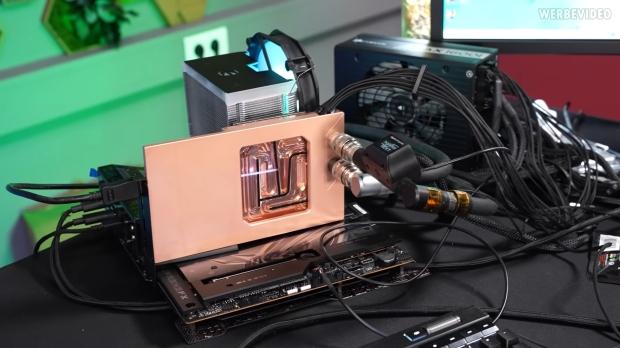Overclocker Der8auer has significantly reduced the operating temperatures of NVIDIA’s GeForce RTX 5090 Founders Edition by installing a custom water block, achieving remarkable drops in both GPU and memory temperatures. This innovative modification showcases the potential for enhanced cooling solutions in high-performance graphics cards.
NVIDIA GeForce RTX 5090 FE with a custom water block: GPU runs 25C cooler, GDDR7 is 30C cooler

Key Takeaways:
- Overclocker Der8auer installed a custom water block on NVIDIA’s RTX 5090 FE, dramatically reducing temperatures.
- The GPU temperature dropped by 25°C, from 75°C to 50°C.
- GDDR7 memory temperatures decreased by 30°C, from 90°C to 60°C.
- NVIDIA’s use of liquid metal on the GB202 GPU contributes to efficient cooling.
- The modification suggests potential for future liquid-cooled Founders Edition cards.
Pushing the Limits of Cooling: Der8auer’s RTX 5090 FE Mod
In the world of high-performance computing, every degree counts. Overclocker Der8auer has taken NVIDIA’s already powerful GeForce RTX 5090 Founders Edition (FE) and pushed its capabilities further by installing a custom water block. The result? Substantial temperature reductions for both the GPU and its new GDDR7 memory.
Disassembling the Beast
Der8auer began by carefully disassembling the RTX 5090 FE to install the custom water block. During this process, he inspected NVIDIA’s use of liquid metal on the GB202 GPU. Using a spectroscope, he discovered that NVIDIA is using a thermal compound “similar to Conductonaut but not as high-performance as their Extreme version.” This insight into NVIDIA’s thermal interface materials highlights their dedication to cooling efficiency.
The Custom Water Block Installation
With the original cooling solution removed, Der8auer installed his custom water block onto the RTX 5090 FE. He utilized Thermal Grizzly’s Kryonaut thermal paste for the GB202 GPU and Thermal Putty Pro for the GDDR7 memory chips and VRMs. Though his prototype used a significant amount of copper, he noted that “if the final version of his water block ever made it to market, it would use less copper…to make the cooler cheaper.”
Impressive Temperature Reductions
The modifications led to remarkable cooling performance. In preliminary testing, the GPU temperature dropped by 25°C, running at 50°C compared to the stock 75°C. Even more impressive was the GDDR7 memory, which saw a temperature decrease of 30°C, now operating at 60°C down from 90°C. These significant reductions demonstrate the effectiveness of the custom water block.
Performance Gains and Observations
Beyond temperature improvements, Der8auer observed a slight increase in GPU clock speeds, hitting 2680MHz—slightly higher than the stock frequency. While the primary goal was cooling efficiency, this indicates potential performance gains resulting from lower operating temperatures.
Implications for Future GPU Design
Der8auer’s successful modification raises interesting prospects for the future of GPU cooling solutions. He mused, “It would be nice to see NVIDIA offer a Founders Edition card with a nice-and-tight dual-slot design like this.” The impressive results suggest that advanced cooling methods, such as custom water blocks, could be integrated into future designs to enhance performance and efficiency.
A Catalyst for Innovation
This experiment not only showcases the potential of the RTX 5090 FE when paired with advanced cooling but also serves as an inspiration for enthusiasts and manufacturers alike. The dramatic temperature reductions achieved without adding any new components beyond the custom cooling solution highlight the untapped potential within existing GPU architectures.
Conclusion
Der8auer’s custom water block modification of NVIDIA’s GeForce RTX 5090 Founders Edition underscores the significant impact that innovative cooling solutions can have on high-performance graphics cards. As the demand for powerful GPUs continues to rise, such advancements may pave the way for future developments in GPU design and cooling technology.











